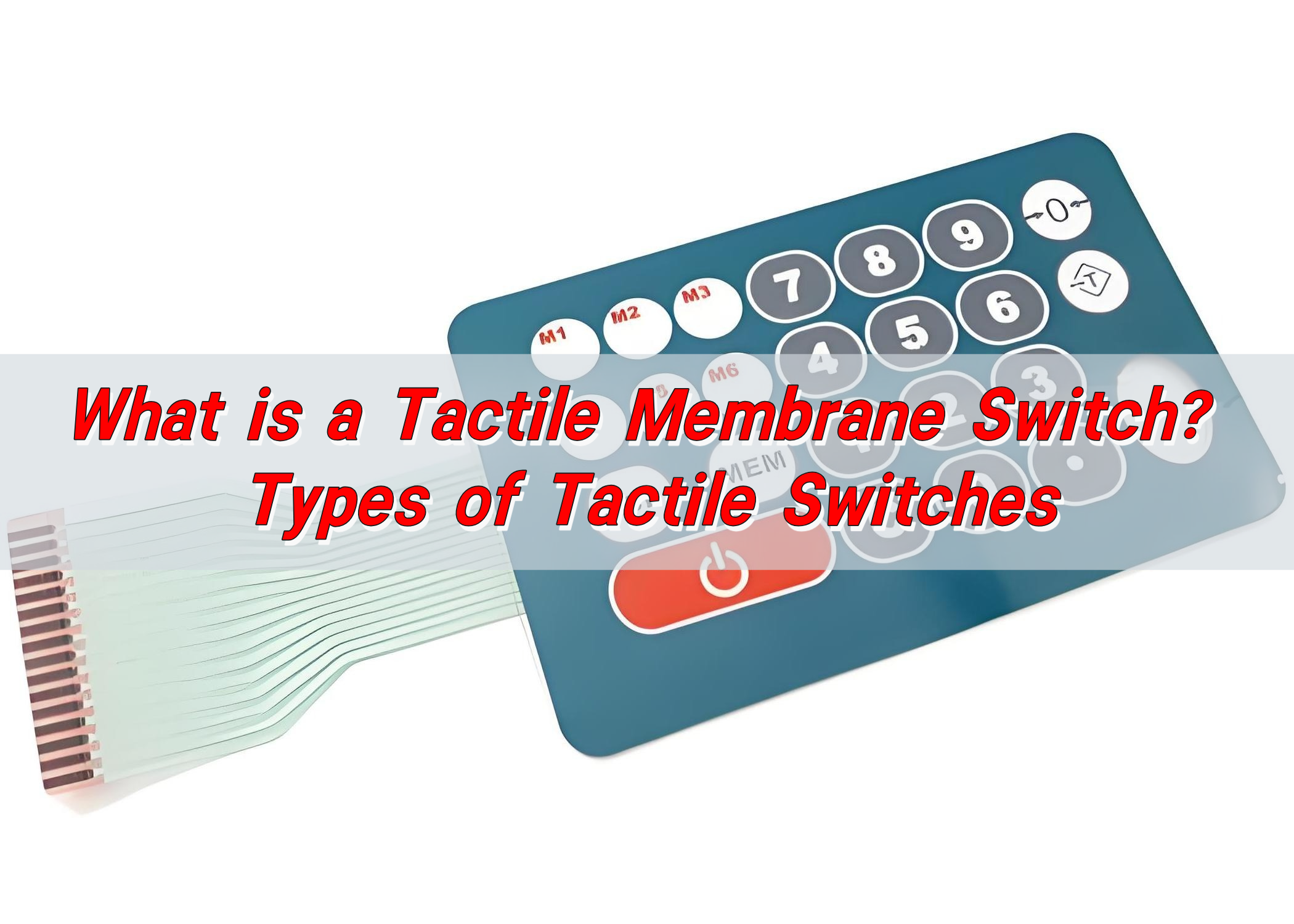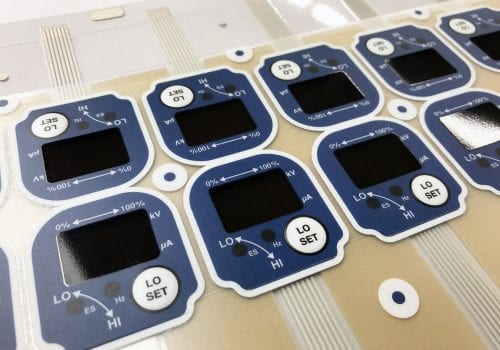The Manufacturing Process Behind Membrane Layer Change: What You Required to Know
The production process behind membrane layer switches over combines cautious design, product choice, and quality assurance. It starts with understanding the intricacies of membrane layer button layout and progresses through various stages, consisting of material choices and printing methods. Each stage plays a necessary duty in making sure performance and sturdiness. The intricacies of layer building and the rigorous screening standards may disclose understandings that are not immediately evident. What exists beyond these foundational components?
Understanding Membrane Layer Change Design
Although membrane layer switches may show up simple at very first look, their layout involves detailed factors to consider that ensure functionality and sturdiness. The design procedure begins with a detailed understanding of individual demands, consisting of the user interface's designated application and ecological variables. Ergonomics is a crucial element, as the format should promote ease of use while ensuring that responsive responses satisfies customer expectations.Moreover, the layering of elements, such as graphic overlays, adhesive layers, and conductive traces, must be precisely crafted. membrane switch. This layered arrangement not just influences the button's responsiveness but additionally impacts its long life. Interest is offered to the sealing methods used to safeguard against dampness and dirt, which might jeopardize efficiency. Additionally, design considerations encompass appearances, where color design and visual clarity boost customer experience. Inevitably, the style of membrane layer switches equilibriums functionality, customer experience, and toughness, ensuring that they fulfill the demands of different applications efficiently
Materials Utilized in Membrane Switch Over Production
When picking products for membrane layer button production, it is important to ponder both efficiency and longevity. The primary materials consist of polyester and polycarbonate movies, which supply versatility and strength. These movies are frequently coated with glue to guarantee appropriate bonding to substrates. Conductive inks, normally composed of silver or carbon, are essential for creating electric links within the switch, permitting trustworthy operation.Additionally, a safety layer, such as a tough layer, is frequently applied to enhance scratch resistance and long life. The choice of backing product, such as acrylic or foam, can considerably affect the switch's responsive feeling and total individual experience. Different ecological factors, including temperature level and humidity, should lead product choice to guarantee peak efficiency in details applications. Eventually, the ideal mix of products contributes to the membrane layer button's performance and life-span, making educated choices crucial for suppliers.
The Printing Refine: Creating Graphics and Text
The printing procedure in membrane button production plays a considerable duty in generating top notch graphics and text. Different visuals layout strategies are used to assure aesthetic appeal and functionality, while careful ink choice techniques are vital for toughness and performance. Recognizing these elements is fundamental for accomplishing ideal cause membrane layer switch design.
Graphic Style Techniques
Graphic design methods play an important duty in the printing process of membrane layer switches, as they specify just how graphics and text will eventually show up on the end product. Effective graphic layout entails the critical use shades, layouts, and font styles to improve readability and aesthetic charm. Designers commonly use vector graphics for scalability, ensuring that photos remain sharp at numerous sizes. Additionally, focus to comparison and positioning is essential, as it affects user communication and aesthetic high quality. The unification of branding elements, such as logos, need to be managed with like preserve brand name stability. On the whole, thoughtful visuals style techniques contribute substantially to the capability and beauty of membrane switches, influencing customer experience and product performance.
Ink Option Techniques
Picking the proper ink is important for achieving the desired visual quality and resilience in membrane switch manufacturing. Numerous ink types are utilized, including solvent-based, water-based, and UV-curable inks. Each type supplies unique characteristics, such as adhesion, resistance, and adaptability to ecological variables. Solvent-based inks are frequently favored for their sturdiness and vibrant colors, while water-based inks are a lot more eco-friendly yet may have limitations in bond. UV-curable inks supply quick curing and durable efficiency. Furthermore, color matching methods ensure that the picked inks align with style specs. Ultimately, the selection of ink should think about factors such as application technique, substratum compatibility, and end-use demands to attain superior results in membrane layer switch graphics and text.
Layer Construction and Assembly

Product Selection Refine
A careful option of products is essential in the production procedure of membrane layer switches, as it directly affects functionality and longevity. The key materials utilized include polyester, polycarbonate, and numerous conductive inks. Polyester is often favored for its outstanding resistance to chemicals and abrasion, making it ideal for severe environments. Polycarbonate, on the various other hand, offers superior quality and impact resistance, which is helpful for applications needing exposure and effectiveness. Conductive inks, usually composed of silver or carbon, are essential for producing reputable electrical paths. Furthermore, the selection of glue materials affects the general check these guys out integrity of the switch - membrane switch. Evaluating aspects such as environmental direct exposure, tactile feedback, and visual needs overviews manufacturers in choosing the very best materials for their details applications
Layer Bond Techniques
Adhering layers in membrane switch building and construction is a vital process that assures functionality and durability. Different attachment strategies are employed to protect optimal bonding between layers, which commonly include making use of adhesives, warm, and stress. Pressure-sensitive adhesives (PSAs) are typically utilized for their ease of application and instant bonding abilities. Additionally, thermal bonding methods can be used, where warmth is made use of to turn on sticky residential or commercial properties, securing a strong bond. The option of bond approach greatly depends upon the materials included and the specific application requirements of the membrane button. Proper placement and consistent application of adhesives are vital to prevent problems, protecting the button operates effectively throughout its desired life-span.
Quality Assurance Measures
Guaranteeing quality assurance throughout the layer building and assembly of membrane switches is essential for keeping efficiency and dependability. This process normally entails several essential measures, including complete evaluations at each phase of production. Producers use innovative testing methods, such as peel tests and attachment evaluations, to confirm the stability of layer bonds. Additionally, visual examinations are carried out to identify any problems in printing or product inconsistencies. Ecological conditions, such as temperature and moisture, are thoroughly kept track of to assure perfect treating and attachment. Regular calibration of equipment aids maintain precise manufacturing requirements. By carrying out these high quality control procedures, manufacturers can significantly reduce the threat of product failing, guaranteeing that the final membrane switches over satisfy the needed specs and consumer expectations.
Evaluating and Top Quality Control Steps

Technologies in Membrane Switch Over Modern Technology
As innovations in technology proceed to evolve, membrane layer switches are benefiting from ingenious growths that improve their functionality and individual experience. One significant advancement is the combination of capacitive touch technology, which permits more intuitive and receptive interface. This shift not just enhances aesthetic appeals however additionally minimizes mechanical deterioration, prolonging the lifespan of the switches.Additionally, developments in visuals overlay products have actually caused enhanced longevity and resistance to ecological factors such as dampness and UV light. These products now provide improved quality and illumination, additional elevating the aesthetic appeal.Furthermore, the consolidation of clever technology is transforming membrane changes right into interactive control panels, enabling connectivity with IoT devices. This connection promotes a seamless user experience, paving the method for applications in numerous markets, from healthcare to consumer electronics. Collectively, these innovations placement membrane layer switches over as essential components in modern-day tool design.
Often Asked Concerns
For how long Does the Membrane Change Production Process Take?
The duration of the membrane layer button manufacturing process can vary substantially. Aspects such as intricacy, materials used, and production quantity impact timelines, with typical production ranging from a few days to a number of weeks for conclusion.
What Are the Typical Applications for Membrane Switches?
Membrane switches are generally used in various industries, consisting of auto controls, home devices, clinical devices, and consumer electronic devices (membrane switch). Their adaptability and durability make them perfect for applications calling for straightforward user interfaces and reputable performance in diverse environments
Can Membrane Layer Switches Over Be Personalized for Details Requirements?

What Is the Life-span of a Typical Membrane Layer Switch Over?
The life-span of a common click this membrane button varies, yet normally, it ranges from 1 to 5 million cycles. Variables such as usage, atmosphere, and worldly quality greatly influence toughness and general efficiency in time.

Are Membrane Layer Switches Eco Friendly?
The ecological friendliness of membrane layer switches over differs. Some materials made use of may not be recyclable, while others can be eco-friendly. The general effect depends on making products and techniques, necessitating mindful factor to consider throughout selection and disposal. The manufacturing procedure behind membrane switches over combines cautious layout, material option, and top quality control. It begins with understanding the details of membrane switch design and advances through different stages, including product choices and printing strategies. When picking materials for membrane button production, it is necessary to ponder both efficiency and toughness. A mindful selection of materials is vital in the production process of membrane layer switches, as it directly influences capability and durability. The selection of adhesion technique largely depends on the products included and the specific application needs of the membrane switch.